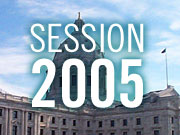January 19, 2005
 |
| The University of Colorado at Boulder. Beginning this fall, college education in that state will be financed through a stipend system, and Minnesota Gov. Tim Pawlenty is interested in adopting a similar program here. (Photo courtesy of the University of Colorado) |
St. Paul, Minn. — Pawlenty said he wants to develop a plan over the next year that would "move Minnesota further toward funding public higher education students, rather than institutions and bureaucracies."
So far, the governor's plan doesn't have many takers.
"I think it's very bad public policy, and it will very substantially erode access and quality of higher education in Minnesota," says University of Minnesota President Bob Bruininks.
Bruininks says the state already funds students directly through one of the country's most generous grant programs. He says he's convinced a strategy like what the governor is floating would decimate the University of Minnesota's academic strength and competitive research position.
"This is a state investment," Bruininks said. "If the state wants to be a leader in the biosciences, if the state wants to be a leader in research related to human health, in science, and many other fields, it has to also invest directly in the core infrastructure and the people who comprise the University of Minnesota."
Currently, 88 percent of the state's higher ed money goes to institutions. The remaining 12 percent goes into the state's grant program.
In his State of the State address, the governor said he's "intrigued" by Colorado's new funding scheme. Starting this summer, that state will begin spending two-thirds of its total state higher education appropriation directly on students. The remaining one-third would go to institutions.
The program, called the College Opportunity Fund, awards up to $2,400 a semester to each student for up to five years of college. It works like a voucher. A student registers for the fund stipend, enrolls in school, and then that school collects the money from the state and applies it toward tuition.
Susan Heegaard, director of the Minnesota Higher Education Services Office and part of the governor's cabinet, says a Colorado-type plan in Minnesota would increase access for students, create more accountability for institutions, and could offer a solution to Minnesota's steady decline in higher education funding.
"Higher ed's getting squeezed across the country," she said. "And I think the concern is how do you try to figure out a way to preserve your investment."
But critics say preserving higher education access means keeping tuition low.
Minnesota state college representative Brad Krasaway says he doesn't like the two-thirds, one-third approach, because when colleges lose state funding, they raise tuition.
"When tuition goes up, it leaves students behind," Krasaway said. "It leaves people that should have or would have gone to college or university to get retrained or out of high school to get trained in the first place, behind, and they won't be able to get into the workforce."
But the people in Colorado say just the opposite is true with their College Opportunity Fund.
Rick O'Donnell, executive director of the Colorado Commission on Higher Education, says it seems counter-intuitive at first, but the two-thirds, one-third funding scheme actually creates stronger support for funding public higher education.
"In the future, if the Legislature wants to cut higher education funding, they're actually going to have to take 300,000 students' stipend and reduce the amount," O'Donnell said. "And those 300,000 students are going to see very clearly what's happening and the consequences of that. And I think it's going to make them a very vocal constituency for the state to keep investing in higher ed."
The Colorado funding scheme is considered the most advanced of its kind. Gov. Pawlenty says Colorado's plan, and others, are worth looking at, and he wants to see a new proposal by 2006 with implementation set for 2008.







